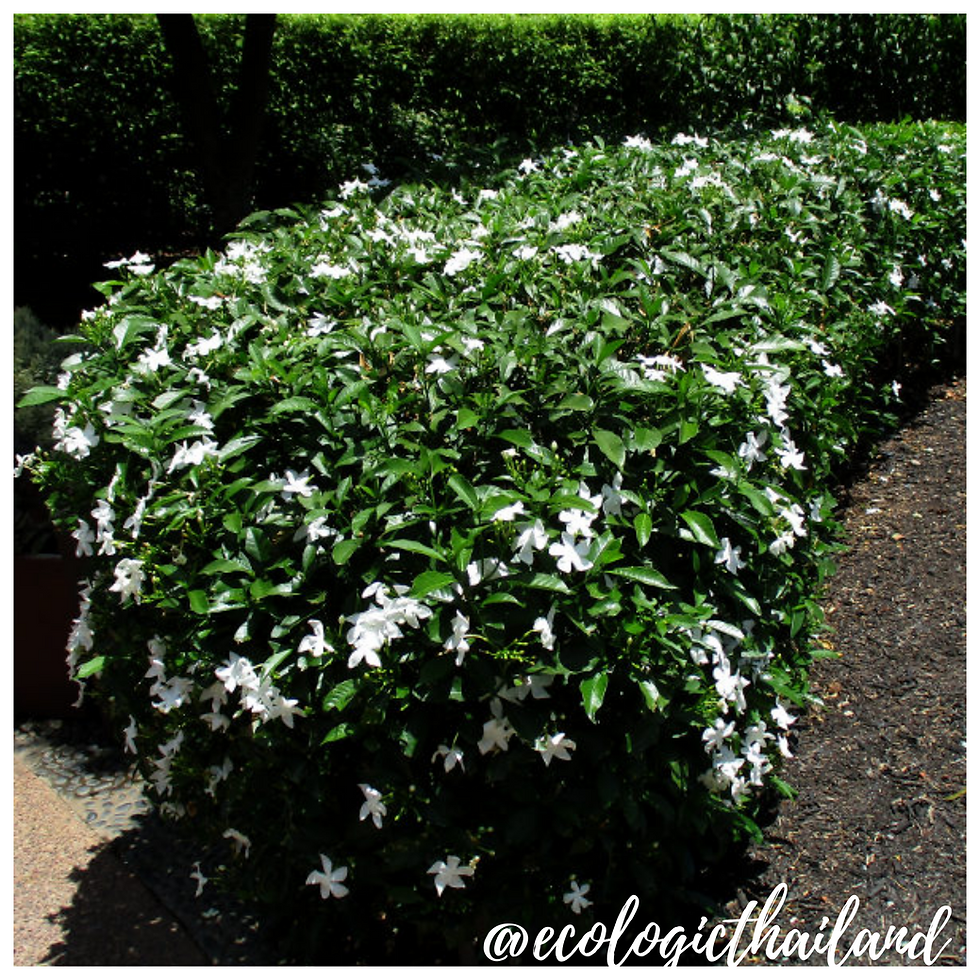Pinwheel flower | Crape Jasmine
- Eco-Logic Resort
- Jun 16, 2021
- 3 min read
Pud Chib | พุดจีบ | Tabernaemontana divaricata
Family: Apocynaceae - Genus: Tabernaemontana

The Crape Jasmine can be found as hedges in the garden of the Amazing Coffee Shop of the Thai Child Development Foundation.
Tabernaemontana divaricata is commonly called pinwheel flower or crape jasmine, but is also known as Ceylon jasmine, Coffee rose, Crepe gardenia, Moonbeam, Paper gardenia, Wax flower, Crape gardenia, pinwheel flower, East Indian rosebay, Flowers-of-love, Adam’s apple, Paper gardenia, Single crepe gardenia.
It is an evergreen shrub native to South Asia and it has flowers throughout the dry season. The flowers are whirled single petaled white flowers.
The plant generally grows to a height of 1.5–1.8 meter and is dichotomously branched. The large shiny leaves are deep green and about 15 centimeter in length and 5.1 centimeter in width. The waxy blossoms are found in small clusters on the stem tips. The (single) flowers have the characteristic 'pinwheel' shape. Both single and double-flowered forms are cultivated, the flowers of both forms being white. The plant blooms in the dry season but flowers appear sporadically all year. The flowers of the single form are unscented but the double-flowered form has a pleasing fragrance.
The Crape Jasmine has flowers all through the dry season, but can bloom the whole year.

THE PLANT
It is a moderately fast-growing shrub, to heights of up to 5 meter in its natural habitat, though is more typically 1 to 3 meter tall with branching starting close to the ground and wide-spreading, forming a densely leafy dome-shaped crown. The bark is grey, wrinkled, marked by leaf scars and exudes a milky sap when wounded.

THE LEAVES
The leaves of the Crape Jasmine are oval, 8 to 15 centimeter long, dark glossy green, prominently veined and with a leathery texture. They are arranged in pairs at the ends of the branches and remain on the plant in all seasons.

THE FLOWERS
The flowers of the Crape Jasmine are small and trumpet-shaped with five waxy white petals in a pin-wheel arrangement. They are borne singularly or in small clusters at the tips of the branches and come into bloom from spring through autumn. Though sweetly fragrant, their scent must be enjoyed at night, as this evaporates in the heat of the day. Their best display is also at night, especially on moonlight nights, due to the waxy petals making the flowers luminous.
Fruit are rare but when produced are curved, ribbed, cylindrical seedpods up to 7 centimeter long. These are borne in pairs and have three to six small seed inside, embedded in fleshy orange or bright red pulp.
CULINARY USES
NOTE: Only the species Jasminum sambac is edible; all other jasmine species are poisonous.
TRADITIONAL MEDICINAL USE
NOTE: please take advice from a doctor if you are planning to use herbal medicine.
In traditional Indian or Ayurvedic medicine, the juice from the flower buds is mixed with oil and applied to the skin to treat inflammation and externally to the eyes as a treatment against Ophthalmia, or inflammation of the eyes.
The Crape Jasmine also offers traditional medicinal benefits such as an anti-epileptic, anti-mania, brain tonic, and anti-oxidant.
INTO THE WILD: a down to earth experience

For guests and visitors to Paksong we organize weekly tours "The Edible Forest" and Foraging weekends: Into the Wild. We work with local guides to take you in the jungle of Paksong. After foraging, we will cook a meal with the ingredients, using bamboo together with you!
Come and join and learn about the abundance of food that nature gives us!
INTO THE WILD!


















Comments